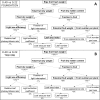Dose-response of tomato fruit yield to far-red fraction in supplementary lighting
- PMID: 40708582
- PMCID: PMC12287650
- DOI: 10.3389/fpls.2025.1618171
Dose-response of tomato fruit yield to far-red fraction in supplementary lighting
Abstract
Supplementary LED lighting in greenhouse horticulture is typically rich in red light (R; 600-700 nm), while it lacks far-red light (FR; 700-800 nm), resulting in growing conditions with lower-than-solar far-red fractions [<0.46; FR/(R + FR)]. In these light environments, the addition of FR can improve tomato harvest index and fruit yield (ripe fruit fresh weight). While fruit yield increases linearly with the dose of FR at low FR fractions (0.1-0.28), it is unknown whether this relationship holds at higher FR levels, up to and above solar FR fractions. In this study, the relationship between tomato fruit yield and the FR fraction in supplementary lighting was quantified. Two cluster tomato cultivars 'Foundation' and 'Trevine' were grown in two greenhouse compartments for 20 weeks during the winter season (September to February). Different fractions of supplementary FR (0.22 to 0.49) were applied while maintaining a constant supplementary photosynthetic photon flux density of 250 µmol m-2 s-1 and 16-hour photoperiod. A yield component analysis was used to identify the key physiological drivers of the FR effect on yield. Additionally, fruit quality at harvest (total soluble solids, soluble sugars, and pH) and shelf-life were assessed. Additional FR increased fruit yield up to an FR fraction of 0.40, where the highest effect was recorded (+16% fruit yield for both cultivars). Fruit yield increases under additional FR were mostly associated with increased plant dry weight, with a small yet significant increase in the fraction of dry matter partitioned to the fruits. The radiation use efficiency (g fruit fresh weight mol-1) and electricity use efficiency of supplementary lighting (g fruit fresh weight kWh-1) decreased at higher FR fractions (0.44 and 0.49). Finally, additional FR had a minimal effect on fruit quality and shelf-life. We conclude that adding FR to supplementary lighting can increase tomato fruit yield linearly up to an FR fraction of 0.40, while at higher FR fractions, further increases in FR have limited or even negative effects on yield and decrease radiation and electricity use efficiency.
Keywords: electricity use efficiency; far-red light; fruit quality; photosynthesis; radiation use efficiency; tomato; vertical light distribution; yield component analysis.
Copyright © 2025 Vincenzi, Moehn, Katsadas, Karbor, de Beer, Millenaar, Marcelis and Heuvelink.
Conflict of interest statement
Author EB was employed by Signify Netherlands B.V. and FM was employed by BASF - Nunhems. The remaining authors declare that the research was conducted in the absence of any commercial or financial relationships that could be construed as a potential conflict of interest. The author(s)declared that they were an editorial board member of Frontiers, at the time of submission. This had no impact on the peer review process and the final decision. The authors declare that this study received funding from BASF - Nunhems and Signify Netherlands B.V. The funders had the following involvement in the study: study design, review and editing of the manuscript. The funders were not involved in the collection, analysis, interpretation of the data, or the decision to submit this article for publication.
Figures





References
-
- Ahamed M. S., Guo H., Tanino K. (2019). Energy saving techniques for reducing the heating cost of conventional greenhouses. Biosyst. Eng. 178, 9–33. doi: 10.1016/j.biosystemseng.2018.10.017 - DOI
-
- Appolloni E., Pennisi G., Paucek I., Cellini A., Crepaldi A., Spinelli F., et al. (2023). Potential application of pre-harvest LED interlighting to improve tomato quality and storability. Postharvest Biol. Technol. 195, 112113. doi: 10.1016/j.postharvbio.2022.112113 - DOI
-
- Beckles D. M. (2012). Factors affecting the postharvest soluble solids and sugar content of tomato (Solanum lycopersicum L.) fruit. Postharvest Biol. Technol. 63, 129–140. doi: 10.1016/j.postharvbio.2011.05.016 - DOI
-
- Demotes-Mainard S., Péron T., Corot A., Bertheloot J., Le Gourrierec J., Pelleschi-Travier S., et al. (2016). Plant responses to red and far-red lights, applications in horticulture. Environ. Exp. Bot. 121, 4–21. doi: 10.1016/j.envexpbot.2015.05.010 - DOI
LinkOut - more resources
Full Text Sources

